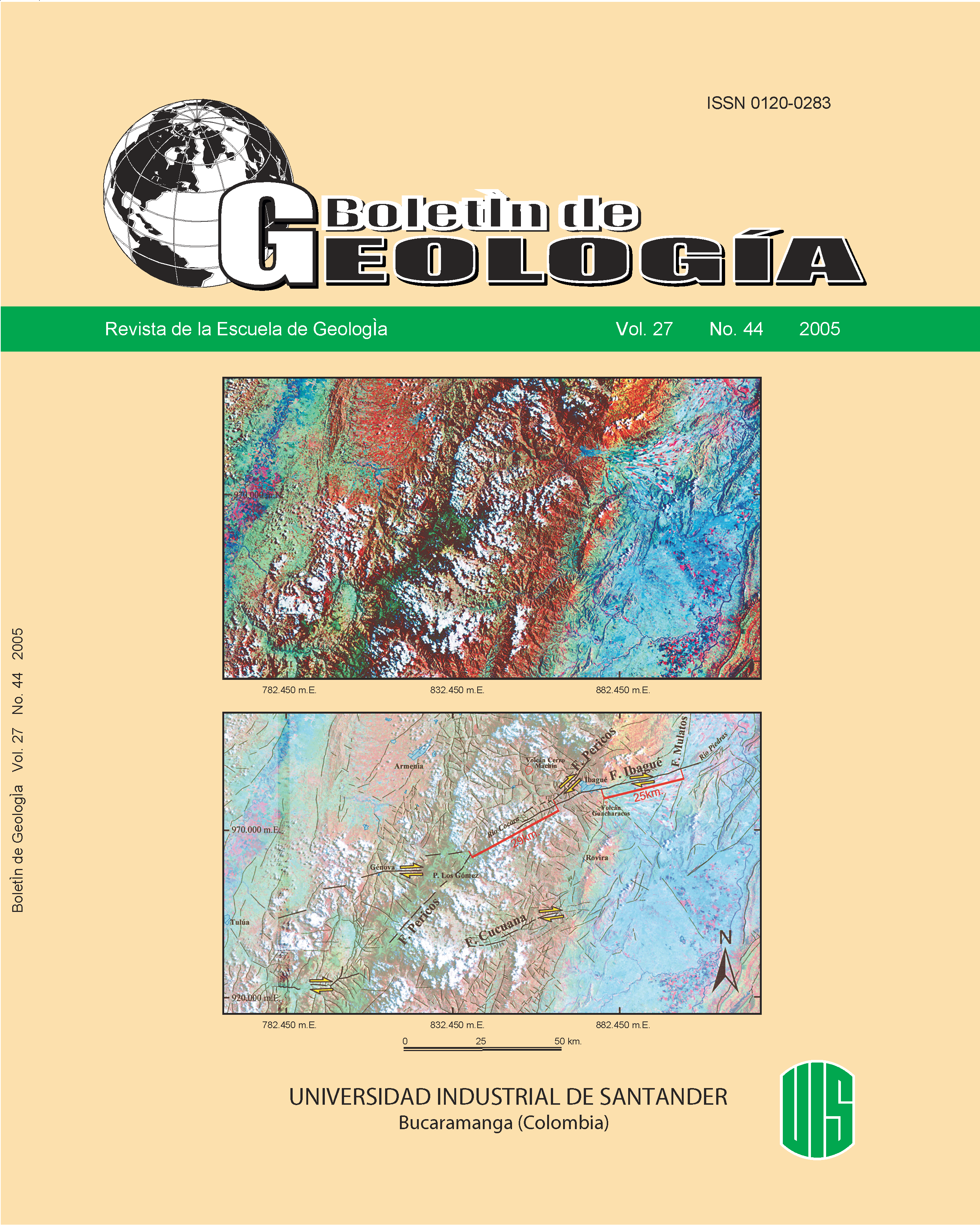Determination present stress tensor for the north segment of the Andes from focal mechanics major earthquakes
Published 2005-01-11
Keywords
- inversion,
- factor shape of tensor,
- stress regime,
- partitioning,
- Andes of the North
How to Cite
Abstract
The northwestern corner of South America presents a complex geodynamic setting due to the interaction of the Nazca, Caribbean and South American plates with the Andean Block. This interaction has been considered as responsible of the current stress state of the Northern Andes, the tectonic setting and the seismic activity. Inversion of focal mechanisms solutions of major earthquakes, shown a compressive stress state. However, the maximum stress varied along the South American margin from WSW-ENE north of 5° N to W-E south of this latitude. We propose that variation of the máximum stress is due to the partitioning of the convergence vector of the Nazca plate with respect to the orientation the Colombia- Ecuadorian trench. We divided this vector into two components. One parallel to the trench (displacement vector) and the other orthogonal to the trench (deformation vector), which is associated to the seismic activity in the coupling zone. These two vectors are transferred to the continent and favor reactivation of fault systems parallel to the Andes. Therefore, north of 5 ° N left lateral displacement along the faults is expected (North Romeral, Murindo and Salinas Faults), whereas south of this latitude right lateral displacement dominates (South Romeral and Algeciras Faults). Displacement of transpressive systems as Garrapatas, Cucuana and Ibagué faults is also facilitated by this stress regime.
Downloads
References
Audemard F., Audemard F. (2001). Structure of the MéridaAndes, Venezuela: relations with the south America-Caribbean geodynamic interaction.Tectonophysics, No.6509, pp. 1-25
Bott, M.H.P. (1959). The mechanism of oblique-slipfaulting. Geol. Mag., Vol 96, pp.109-117.Consejo de Seguridad Nacional de España. (1998).Proyecto SIGMA: Análisis del estado de esfuerzostectónicos, reciente y actual en la Península Ibérica.Madrid: CSN. 239 p
Duque-Caro H. (1990). El Bloque Chocó en elNoroccidente Suramericano: Implicaciones estructurales,tectonoestratigráficas y paleográficas. Bol. Geol.Ingeominas. Vol. 31, No. 1, pp. 50-71
Gutscher, M.-A., Malavieille J., Lallemand S., Collot J.-Y.(1999).Tectonic segmentation of the North Andean margin:impact of the Carnegie Ridge collision. Earth and PlanetaryScience Letters, pp. 255-270.
INGEOMINAS. (2001). Base de datos de Mecanismosfocales de Colombia.
Pegoraro, O. (1972). Applicattion de la microtectonique áun étude de neotectonique. Le golfe Maliaque. Thèse lIIèmecycle. U.S.T.L. Montpellier. 41
Philip H. (1987). Plio-quaternary evolution of the stressfield in Mediterranean zones of subduction and collision.Annales Geophysicae. Vol. 3, No. 5B, pp. 301-320.
Reches, Z. (1987). Determination of tectonic stress tensorfrom slip along faults that obey the Coulomb yield conditio.Tectonics. Vol. 7, pp. 849-861
Reches, Z., Baer, G., Hatzor, Y. (1992). Constraints onthe strength of the Upper Crust from stress inversion offault slip data. J. Geophys. Res., Vol 97, pp.12481-12493.
Reches, Z. (1996). Inversion of fault slip data and focal-plane solutions. Software Stress versión 2.9
Taboada A., Rivera L., Fuenzalida A., Cisternas A., PhilipH., Bijwaard H., Olaya J., Rivera C. (2000). Geodynamicsof the nortern Andes: Subductions and intracontinentaldeformation (Colombia). en: Tectonics. Vol. 19, No. 5.pp. 787-813
Trenkamp R., Kellogg J., Freymueller J., Mora H. (2002).Wide plate margin deformation, southern Central Americaand northwestern South America; CASA GPSobservations. Journal of South American Earth Sciences.Vol. 15, No. 2, pp. 157-171
Van der Hils R., Mann P. (1994). Tectonic implications oftomographic images of subducted lithosphere beneathnorthwestern South America. En: Geology. Vol. 22, pp.451-454.
